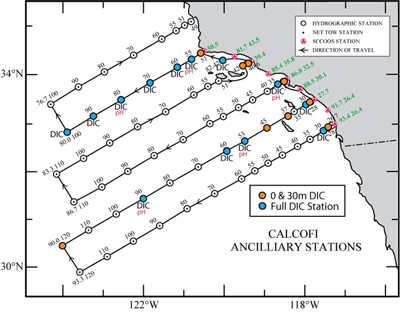Category: Field Work
-
Primary Productivity Sampling
Primary Productivity Primary productivity samples are taken each day shortly before local apparent noon (LAN). Primary production is estimated from 14C uptake using a simulated in-situ technique. Light penetration is estimated from the Secchi depth (assuming that the 1% light level is three times the Secchi depth). The depths with ambient light intensities corresponding to…
-
Dissolved Oxygen
Dissolved Oxygen The amount of dissolved oxygen in seawater is measured using the Carpenter modification of the Winkler method. Carpenters modification (1965) was designed to increase the accuracy of the original method devised by Winkler in 1889. Using Carpenters modification, the significant loss of iodine is reduced and air oxidation of iodide is minimized. Rather…
-
Nutrient Sampling
Nutrients The phytoplankton macro nutrients nitrate, nitrite, silicate, phosphate and ammonium are analyzed in seawater using a colorimetric assay in which light absorbance is measured versus known standards. To analyze for nutrients a Seal Analytical continuous-flow AutoAnalyzer 3 (AA3) is used. After each run, the charts are reviewed for any problems, any blank is subtracted,…
-
Dissolved Organic Carbon & Total Nitrogen
CCE LTER analyzes and determins total organic carbon (TOC) and total nitrogen (TN) in sea water, expressed as micromoles of carbon (nitrogen) per liter of sea water. TOC (<200 µmol·L-1) includes both dissolved and particulate organic carbon (DOC and POC, respectively). TN (<50 µmol·L-1) includes particulate and dissolved organic nitrogen as well as dissolved inorganic…
-

Station Operations
Station Operations Scientific operations on CalCOFI cruises are scheduled 7/24 – around the clock 7 days a week. Scientists, technicians, and volunteers typically work 12hr shifts scheduled from noon to midnight or midnight to noon. In good weather, the ship transits at ~10kts to minimize ship noise in the fisheries acoustics data. Transits between stations…
-
Picophytoplankton & Prokaryotes
CCE-LTER samples picophytoplankton populations and non-pigmented prokaryotes within the California Current Ecosystem (CCE) are fixed in the field by the addition of paraformaldehyde and, in the laboratory, stained with Hoechst 33342 (a DNA specific dye). The cells are enumerated by an Altra flow cytometer and converted to biomass estimates Complete methods for picoplankton and bacteria…
-
Particulate Organic Carbon & Nitrogen
CCE LTER measures particulate organic carbon (POC) and nitrogen (PON) by high-temperature combustion. Samples analyzed within the California Current Ecosystem constrain the mean C:N ratio of small particulates and by difference relative to measured living biomass, the biomass of suspended detritus. Complete methods of POC and PON determination can be found here.
-
Salinity Sampling
Salinity On each station, seawater salinity samples of ~225 mL are drawn from all CTD-rosette bottles closed during the cast. A Guildline Instruments Portasal™ Salinometer (8410A) measures the seawater sample conductivity precisely, comparing it to a reference seawater standard. From these comparisons, salinities are calculated and logged using Windows-PC based software that averages data that…
-
Chlorophyll-a
Chlorophyll-a & Phaeopigments Chlorophyll a is cold-extracted in a 90% acetone solution for ~24 hours. Chlorophyll and phaeopigments are then measured fluorometrically using an acidification technique. The method used today is based on those developed by Yentsch and Menzel (1963), Holm-Hansen et al. (1965) and Lorenzen (1967). Note that concentrations of ‘phaeopigments’ are not a…
-

Dissolved Inorganic Carbon
DIC: Dissolved Inorganic Carbon The CalCOFI group collects samples for the characterization of the inorganic carbon system at selected locations along the cruise track. Total inorganic carbon and alkalinity are measured which allows the calculation of pH and pCO2. The objectives of these measurements are: first, the long-term characterization of the inorganic carbon system and…